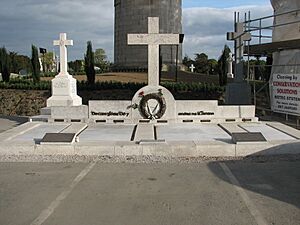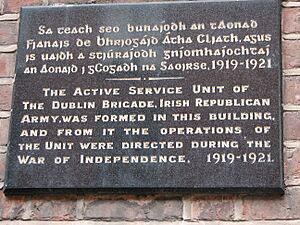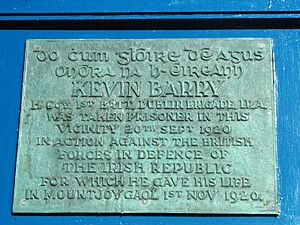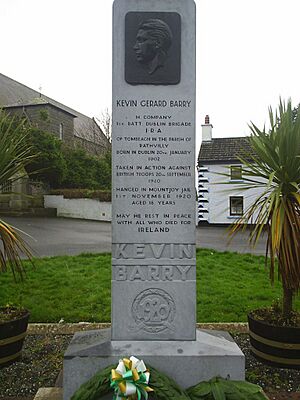Kevin Barry facts for kids
Quick facts for kids
Kevin Barry
|
|
|---|---|

Kevin Barry in the rugby jersey of Belvedere College, Dublin
|
|
| Born |
Kevin Gerard Barry
20 January 1902 Fleet Street, Dublin, Ireland
|
| Died | 1 November 1920 (aged 18) Mountjoy Jail, Dublin, Ireland
|
| Cause of death | Execution by hanging |
| Nationality | Irish |
| Occupation | Medical student |
| Known for | Executed Irish Republican Army volunteer |
| Military career | |
| Allegiance | |
| Service/ |
North Dublin |
| Years of service | 1917–1920 |
| Battles/wars | Irish War of Independence |
Kevin Gerard Barry (20 January 1902 – 1 November 1920) was an Irish Republican Army (IRA) soldier who was executed by the British Government during the Irish War of Independence. He was sentenced to death for his part in an attack upon a British Army supply lorry which resulted in the deaths of three British soldiers.
His execution inflamed nationalist public opinion in Ireland, largely because of his age. The timing of the execution, only seven days after the death by hunger strike of Terence MacSwiney, the republican Lord Mayor of Cork, brought public opinion to a fever-pitch. His pending death sentence attracted international attention, and attempts were made by U.S. and Vatican officials to secure a reprieve. His execution and MacSwiney's death precipitated an escalation in violence as the Irish War of Independence entered its bloodiest phase, and Barry became an Irish republican martyr.
Contents
Early life
Kevin Barry was born on 20 January 1902, at 8 Fleet Street, Dublin, to Thomas and Mary (née Dowling) Barry. The fourth of seven children, two boys and five girls, Kevin was baptised in St Andrew's Church, Westland Row. His father, Thomas Barry Sr., ran a prosperous dairy business in Dublin based at Fleet Street and supported by the output of the family's farm at Tombeagh, Hacketstown, County Carlow. Thomas Barry Sr. died of heart disease on 8 February 1908, at the age of 56, when Kevin was six years old.
Kevin Barry's mother, the former Mary Dowling, came from Drumguin, County Carlow, and, upon the death of her husband, moved the family to the farm at Tombeagh while retaining the family's townhouse on Fleet Street. As a child he went to the National School in Rathvilly. In 1915 he was sent to live in Dublin and attended the O'Connell Schools for three months, before enrolling in the Preparatory Grade at St Mary's College, Rathmines, in September 1915. He remained at that school until 31 May 1916 when it was closed by its clerical sponsors.
During this period he was undoubtedly affected by the events in April of the Easter Rising.
Belvedere College
With the closure of St Mary's College, Barry transferred to Belvedere College, a Jesuit school in Dublin. He was a substitute on the championship Junior Rugby Cup team, and earned a place on the senior team. In 1918 he became secretary of the school hurling club which had just been formed, and was one of their most enthusiastic players.
In 1919, his final year at Belvedere, Barry wrote an essay supporting the Dublin Lockout as a "forcible demonstration of the power of Labour and had an experience also of the power of agitation in the person of that marvellous leader James Larkin and his able lieutenant, Commandant James Connolly". This piece earned him only sixty points out of a possible 100. Generally speaking, Barry's performance as a student was erratic. In his first and third years at Belvedere, he won no honours, although he did earn honours in five subjects in his middle year. He must have learned more than his grades reflected. After graduation, he won a merit-based scholarship given annually by Dublin Corporation, which allowed him to become a student of medicine at University College Dublin (UCD).
Medical student
Barry entered UCD as a first-year medical student in October 1919 and remained a student for the next year. His closest friend at UCD was Gerry MacAleer, from Dungannon, whom he had first met in Belvedere. Another friend at UCD was Frank Flood, whom he had met at the O'Connell Schools, and was now an engineering student at the university.
Barry's medical studies competed with other attractions, including dancing and cinema. As a result, he only managed to attend about three-quarters of his medical school lectures. Not least of his distractions was his membership in the Irish Volunteers. Barry was one of several UCD medical students involved in the Volunteers, including Tom Kissane, Liam Grimley and Mick Robinson, all of whom were involved with Barry in the Monk's Bakery ambush, along with Frank Flood. Kissane, Grimley, Robinson and Flood all survived the ambush unscathed. Flood was later captured and executed by the British in 1921.
Despite Barry's extensive involvement in Volunteer actions, he appears to have been very discreet. Although Barry was a member of the Volunteers for three of the four years of their friendship, his closest friend, Gerry McAleer was unaware of this aspect of his life.
Volunteer activities
In October 1917, during his second year at Belvedere, aged 15, he joined Company C, 1st Battalion of the Dublin Brigade of the Irish Volunteers. When Company C was later reorganized he was reassigned to the newly formed Company H, under the command of Captain Seamus Kavanagh. He was attached to Company C, of the 3rd Battalion of the Carlow Brigade during his vacations from school in Tombeagh.
The following year, at age 16, he was introduced by Seán O'Neill and Bob O'Flanagan to the Clarke Luby Club of the Irish Republican Brotherhood (IRB). At some point in time, he was sworn as a member of this secret society which was led by Michael Collins.
Although he served in the Volunteers for almost three years, his operational experience prior to the Monk's Bakery ambush was somewhat limited. For the most part, Volunteers in Dublin did little other than training and few saw action or heard shots fired in anger.
Ambush
In mid-September 1920, Captain Seamus Kavanagh, Commander of H Company of the Dublin Brigade, was approached by James Douglas of C Company. Douglas informed him that he and John Joe Carroll of H Company had noticed that a British army lorry guarded by an armed party of soldiers made twice weekly trips to Monk's Bakery at 79-80 Church Street to obtain bread.
After obtaining permission to conduct the ambush Captain Kavanagh selected men from his company to participate and developed his detailed plan. At this time, Kevin Barry was a member of Company C, but upon returning to Dublin from vacation he learned of the operation and asked Captain Kavanagh if he could participate.
On the morning of 20 September 1920, Barry went to Mass, then joined a party of IRA volunteers on Bolton Street in Dublin.
The ambush did not go as planned. Barry's comrades fled and he was left behind. He was then spotted and arrested by the soldiers. One of the soldiers, Private Harold Washington, had been shot dead. Two others, Privates Marshall Whitehead and Thomas Humphries, were both badly wounded and later died of their wounds.
Trial and execution
Barry was charged on three counts of the murder of Private Marshall Whitehead. He was sentenced to execution, which took place at Mountjoy Prison, Dublin, on 1 November, 1920.
On 14 October 2001, the remains of ten Irish republicans, including Barry, were given a state funeral and moved from Mountjoy Prison to be re-interred at Glasnevin Cemetery in Dublin.
Aftermath

The only full-length biography of Kevin Barry was written by his nephew, journalist Donal O'Donovan, and published in 1989 as Kevin Barry and his Time. In 1965, Sean Cronin wrote a short biography, simply entitled "Kevin Barry"; this was published by The National Publications Committee, Cork, to which Tom Barry provided a foreword. Barry is remembered in a well-known song about his imprisonment and execution, written shortly after his death and still sung today. The tune to "Kevin Barry" was taken from the sea-shanty "Rolling Home". The execution reportedly inspired Thomas MacGreevy's surrealist poem, "Homage to Hieronymus Bosch". MacGreevy had unsuccessfully petitioned the Provost of Trinity College Dublin, John Henry Bernard, to make representations on Barry's behalf.
Legacy
In 1930, Irish immigrants in Hartford, Connecticut, created a hurling club and named it after Barry. The club later disappeared for decades but was revived in 2011 by more recently arrived Irish immigrants and local Irish-Americans in the area. A commemorative stamp was issued by the Department of Posts and Telegraphs to mark the 50th anniversary of Barry's death in 1970. The University College Dublin and University of Galway branches of Ógra Fianna Fáil are named after him. Derrylaughan Kevin Barry's GAA club was founded in Clonoe, County Tyrone.
In 1934, a large stained-glass window commemorating Barry was unveiled in Earlsfort Terrace, then the principal campus of University College Dublin. It was designed by Richard King of the Harry Clarke Studio. In 2007, UCD completed its relocation to the Belfield campus some four miles away and a fund was collected by graduates to defray the cost (estimated at close to €250,000) of restoring and moving the window to this new location. A grandnephew of Kevin Barry is Irish historian Eunan O'Halpin. There is an Irish republican flute band named after him in Glasgow, the "Volunteer Kevin Barry Republican Flute Band".
Barry's execution is mentioned in the folk song "Rifles of the I.R.A.", which was written by Dominic Behan in 1968. The ballad "Kevin Barry", relating the story of his execution, has been sung by artists such as Paul Robeson, Leonard Cohen, Lonnie Donegan, Stompin' Tom Connors, the Hootenanny Singers, Damien Dempsey, The Clancy Brothers, Tommy Makem and The Dubliners. At the place where Kevin Barry was captured (North King Street/Church Street, Dublin), there are two blocks of flats named after him.







